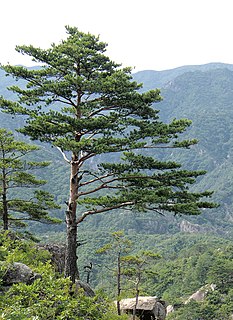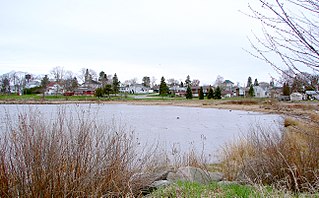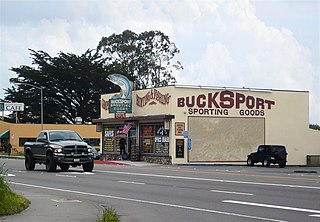Atlantic Coast Lumber Company was formed in 1899 when the potential value of the vast amounts of standing timber in the Pee Dee River watershed was discovered by a group of Northern lumbermen. Options were taken by the company on this timber and that of surrounding counties. A large sawmill was built west of the city of Georgetown and production began. In 1903, the company was incorporated with a capital of one million dollars.

The Pee Dee River, also known as the Great Pee Dee River, is a river in the U.S. states of North Carolina and South Carolina. It originates in the Appalachian Mountains in North Carolina, where its upper course, above the mouth of the Uwharrie River, is known as the Yadkin River. It is extensively dammed for flood control and hydroelectric power. The lower part of the river is named Pee Dee after the Pee Dee Indian Tribe. The Pee Dee region of South Carolina, composed of the northeastern counties of the state, was also named after the tribe. In fact, today the Pee Dee Indian Tribe still occupies some of their ancestral lands, although the tribe only consists of just over 200 enrolled members. The first Europeans believed to have navigated part of the river was a party sent by Lucas Vázquez de Ayllón in 1521. They named it "River of St. John the Baptist."

A sawmill or lumber mill is a facility where logs are cut into lumber. Modern saw mills use a motorized saw to cut logs lengthwise to make long pieces, and crosswise to length depending on standard or custom sizes. The "portable" saw mill is iconic and of simple operation—the logs lay flat on a steel bed and the motorized saw cuts the log horizontally along the length of the bed, by the operator manually pushing the saw. The most basic kind of saw mill consists of a chainsaw and a customized jig, with similar horizontal operation.
The mill was expanded through the years, and included three separate sawmills, two shipping wharves, several warehouses, and numerous other buildings, including workers' houses, stores, a hotel, a church, etc. The company owned all of these buildings, making the area immediately surrounding the mill a veritable "company town", (see photo below). In 1913, a disastrous fire destroyed two of the sawmills. A new steel and concrete mill was erected within ten months. At peak production, the company could produce 600,000 board feet (1,400 m³) of lumber per day and was properly proclaimed "the largest lumber manufacturing plant on the Atlantic Coast." Due to the effects of the Great Depression, the plant was closed in 1932.

A company town is a place where practically all stores and housing are owned by the one company that is also the main employer. Company towns are often planned with a suite of amenities such as stores, churches, schools, markets and recreation facilities. They are usually bigger than a model village.

The Great Depression was a severe worldwide economic depression that took place mostly during the 1930s, beginning in the United States. The timing of the Great Depression varied across nations; in most countries it started in 1929 and lasted until the late-1930s. It was the longest, deepest, and most widespread depression of the 20th century. In the 21st century, the Great Depression is commonly used as an example of how intensely the world's economy can decline.
It was a major undertaking to move millions of tons of rock to the two barrier islands at the entrance to the harbor and build "jetties" of over 11,000 feet on the north and 21, 000 feet on the south entrance of the bay, with steam and sail power. A dredge was built to maintain a channel and, coupled with the railway and the river system, the lumber business flourished. Mills sprang up almost overnight. The Atlantic Coast Lumber Company was the largest in the world with its 5,000,000 board foot (12,000 m³) dock and shed. Turpentine, pine rosin, shingles, furniture - but none as unusual as the DuPont wood alcohol and dynamite mill.

Lumber or timber is a type of wood that has been processed into beams and planks, a stage in the process of wood production. Lumber is mainly used for structural purposes but has many other uses as well.

Turpentine is a fluid obtained by the distillation of resin from live trees, mainly pines. It is mainly used as a solvent and as a source of materials for organic synthesis.

A pine is any conifer in the genus Pinus of the family Pinaceae. Pinus is the sole genus in the subfamily Pinoideae. The Plant List compiled by the Royal Botanic Gardens, Kew and Missouri Botanical Garden accepts 126 species names of pines as current, together with 35 unresolved species and many more synonyms.

Blind River is a town situated on the North Channel of Lake Huron in the Algoma District, Ontario, Canada. The town, named after the nearby Blind River, celebrated its centennial in 2006.
Muscogee, is a ghost town located twenty miles northwest of Pensacola, Florida, United States, in Escambia County, along the Perdido River. Named after the Muscogee Lumber Company, formed by Georgia lumber men, the European-American town was founded in 1857 by a group of lumbermen to harvest timber from the surrounding pine forests. They and the following company clearcut the timber, and once the forests were gone, lumbering ended in this area.

Pequaming is an unincorporated community in L'Anse Township of Baraga County in the U.S. state of Michigan. It is located on a narrow point of land that juts into Keweenaw Bay. Although still partially inhabited, Pequaming is one of the largest ghost towns in the Upper Peninsula of Michigan.
Bucksville is a small unincorporated community in Horry County, South Carolina, United States. It lies near Bucksport on the Pee Dee River and Waccamaw River. Two properties are listed on the National Register of Historic Places: the Buck's Upper Mill Farm and Hebron Church.
The Susquehanna Boom was a system of cribs and chained logs in the West Branch Susquehanna River, designed to catch and hold floating timber until it could be processed at one of the nearly 60 sawmills along the river between Lycoming and Loyalsock Creeks in Lycoming County, Pennsylvania in the United States. The Susquehanna Boom was originally built under the supervision of James H. Perkins, and operated from 1851 to 1909, when it shut down for lack of timber.

The Meadow River Lumber Company, which operated in Rainelle, West Virginia from 1906 to 1975, was the largest hardwood sawmill in the world. It had three 9 feet (2.7 m) bandsaws under one roof. In 1928, during peak production, its 500 employees produced 31 million board feet of lumber, cutting 3,000 acres (12 km2) of virgin timber a year.
The Great Southern Lumber Company was chartered in 1902 to harvest and market the virgin longleaf pine forests in southeastern Louisiana and southwestern Mississippi. Bogalusa, Louisiana was developed from the ground up as a company town and was the location for Great Southern Lumber Company's sawmill, which began operation in 1908. Other company interests included a railroad and paper mill. The company ceased operation in 1938, when the supply of virgin pines was depleted. Bogalusa became the site of a paper mill and chemical operations, followed by other industry.

Rockport is a former settlement in an unincorporated area of Mendocino County, California. It is located 7.25 miles (12 km) north-northwest of Westport, at an elevation of 30 feet.

Bucksport was a town in Humboldt County, California. The original location was 2.5 miles (4 km) southwest of downtown Eureka, on Humboldt Bay about 5 miles (8 km) northeast of entrance. at an elevation of 16 feet (4.9 m). Prior to American settlement a Wiyot village named Kucuwalik stood here.

Andersonia is an unincorporated community in Mendocino County, California. It is located near U.S. Route 101 on the South Fork of the Eel River 1 mile (1.6 km) north-northwest of Piercy, at an elevation of 541 feet.

Graf Brothers Flooring and Lumber specializes in, and is the world's largest manufacturer of, rift and quarter sawn oak products. Rift & Quartered lumber results from a unique way of sawing that maximizes the yield of lumber with vertical grain. Vertical grain is preferred because of its excellent technical properties. Lumber that has been sawed using this method expands evenly and vertically. Vertical grain also increases the structural integrity of the wood.
The Finkbine-Guild Lumber Company was established to harvest and market the virgin longleaf pine stands of southern Mississippi during the early 20th century. The main sawmills were located in Wiggins and D'Lo, Mississippi. When the local timber supply dwindled, the company tried to utilize redwood trees from California, but that operation failed because of high transportation costs. Other attempts were made at promoting a more diversified use of the cutover timberlands; some ventures were successful while others were not.

Western Forest Products Inc. is a Canadian lumber company based in Vancouver, British Columbia, Canada.

The Spruce Production Division was a unit of the United States Army that was established in 1917 to produce high-quality Sitka spruce timber and other wood products needed to make aircraft for the United States' efforts in World War I. The division was part of the Army Signal Corps's Aviation Section. Its headquarters were in Portland, Oregon, and its main operations center was at Vancouver Barracks in Vancouver, Washington. Workers in the division were members of the Loyal Legion of Loggers and Lumbermen, a union specifically established to support the army's wood production operations.

Pine Creek Gorge, sometimes called The Grand Canyon of Pennsylvania, is a 47-mile (76 km) gorge carved into the Allegheny Plateau by Pine Creek in north-central Pennsylvania.

The Ottawa River timber trade, also known as the Ottawa Valley timber trade or Ottawa River lumber trade, was the nineteenth century production of wood products by Canada on areas of the Ottawa River destined for British and American markets. It was the major industry of the historical colonies of Upper Canada and Lower Canada and it created an entrepreneur known as a lumber baron. The trade in squared timber and later sawed lumber led to population growth and prosperity to communities in the Ottawa Valley, especially the city of Bytown. The product was chiefly red and white pine. The industry lasted until around 1900 as both markets and supplies decreased.

Shanagolden is an unincorporated community located in the town of Shanagolden, Ashland County, Wisconsin, United States. Shanagolden is located on the East Fork Chippewa River 10 miles (16 km) northwest of Butternut.
L.N. Dantzler Lumber Company began as a small sawmill in Moss Point, Mississippi and was incorporated in 1888. Originally, the main business was the manufacture of lumber from southern yellow pine, but the company switched to tree farming of southern pines in 1949. The family-owned company prospered for 75 years but was sold to International Paper Company in 1966.

The Carson and Tahoe Lumber and Fluming Company (C&TL&F) was formed to move lumber from trees growing along the shore of Lake Tahoe to the silver mines of the Comstock Lode. Between 1872 and 1898 C&TL&F transferred 750 million board foot of lumber logged from 80,000 acres (32,000 ha) of virgin timberland.


















